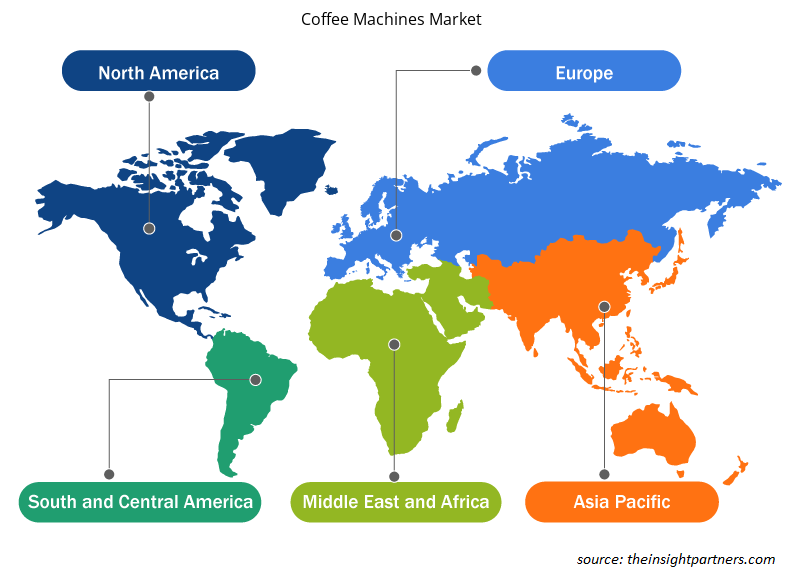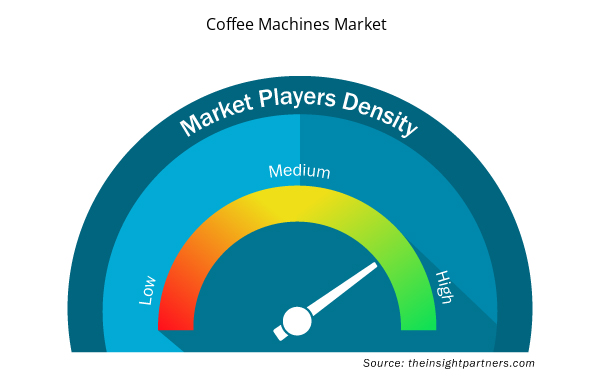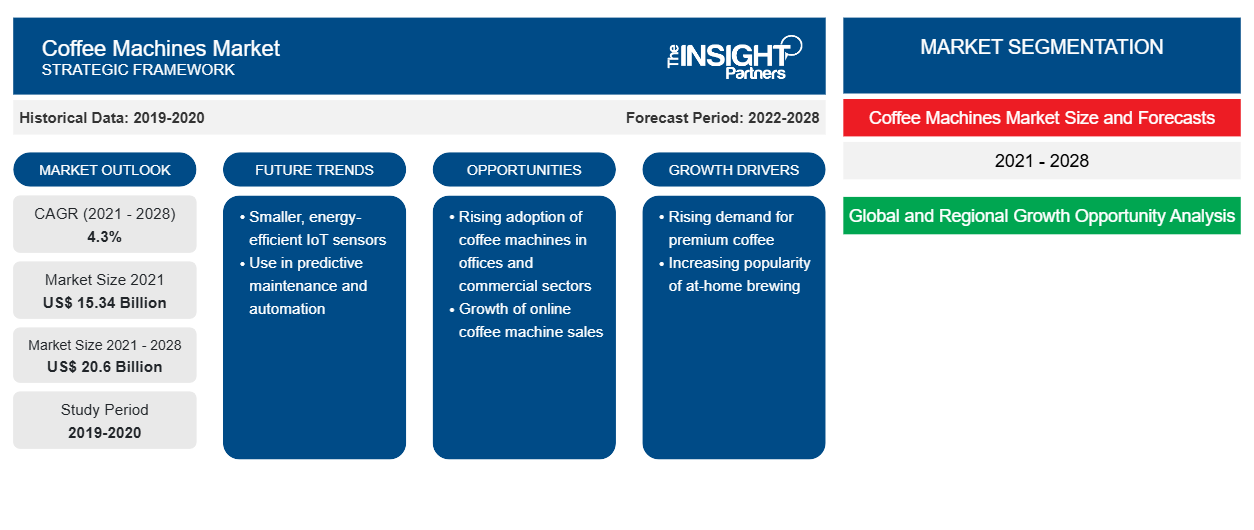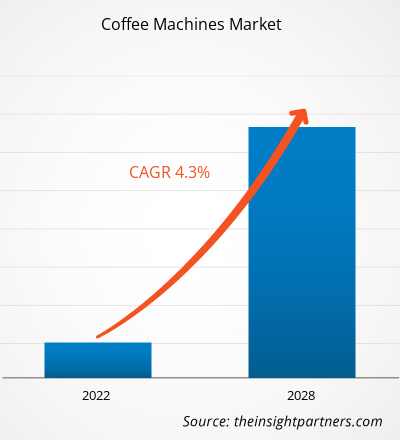[Rapporto di ricerca] Il mercato delle macchine da caffè è stato valutato a 15.340,75 milioni di dollari nel 2021 e si prevede che raggiungerà i 20.596,79 milioni di dollari entro il 2028; si prevede che crescerà a un CAGR del 4,3% dal 2021 al 2028.CAGR of 4.3% from 2021 to 2028.
Approfondimenti di mercato e opinioni degli analisti:
La macchina da caffè è un dispositivo utilizzato per preparare il caffè. Esistono vari tipi di macchine da caffè come la pressa francese, la macchina per caffè espresso, la macchina per caffè filtro, la macchina per caffè a capsule e cialde, tra le altre. Ogni macchina funziona con un meccanismo diverso. Ad esempio, in una macchina per caffè filtro, l'acqua gocciola automaticamente in un tubo riscaldante e viene versata sul caffè macinato che passa attraverso un filtro. Tuttavia, in una macchina per caffè a capsule e cialde, il caffè è confezionato in una capsula di plastica o alluminio e contenuto in un piccolo contenitore che entra nella macchina per il caffè, e il caffè viene preparato. C'è una crescente domanda di macchine da caffè nei settori aziendali e istituzionali. Questo fattore sta guidando in modo significativo il mercato delle macchine da caffè a livello globale.
Fattori di crescita e sfide:
Negli ultimi anni, lo stile di vita delle persone è cambiato radicalmente a causa di orari di lavoro frenetici e prolungati. A causa dello stile di vita frenetico, le persone si stanno spostando sempre di più verso cibi e bevande pronti. Nel settore aziendale, le persone sono continuamente esposte allo stress correlato al lavoro, per cui cercano tempo libero da trascorrere con i colleghi e gli amici. Il caffè è una delle bevande versatili ampiamente consumate per il suo sapore e aroma appaganti. Inoltre, il suo contenuto di caffeina aiuta a migliorare l'umore e a indurre la motivazione. Questo fattore sta guidando in modo significativo l'industria del caffè in tutto il mondo. Le macchine da caffè aiutano a preparare il caffè all'istante, motivo per cui c'è un'elevata domanda di macchine da caffè nel settore aziendale. Questo fattore sta guidando in modo significativo il mercato delle macchine da caffè. Tuttavia, poiché la consapevolezza della natura altamente avvincente del caffè sta aumentando tra le persone, stanno sostituendo il caffè con altre bevande come succhi di frutta naturali, bubble tea, acque frizzante, ecc. Inoltre, la crescente consapevolezza delle implicazioni negative per la salute dell'elevato consumo di caffeina sta ostacolando anche la domanda di caffè tra gli individui. Si prevede che questi fattori avranno un impatto negativo sul consumo di caffè, frenando la domanda di macchine da caffè nel periodo di previsione.
Personalizza questo report in base alle tue esigenze
Riceverai la personalizzazione gratuita di qualsiasi report, comprese parti di questo report, o analisi a livello nazionale, pacchetto dati Excel, oltre a usufruire di grandi offerte e sconti per start-up e università
- Scopri le principali tendenze di mercato in questo rapporto.Questo campione GRATUITO includerà analisi di dati che spaziano dalle tendenze di mercato alle stime e alle previsioni.
Segmentazione e ambito del report
Il "mercato globale delle macchine da caffè" è segmentato in base a tipo, categoria, utente finale e area geografica. In base al tipo, il mercato delle macchine da caffè è segmentato in macchine da caffè filtro, macchine da caffè espresso, macchine da caffè a capsule e cialde e altre. In base alla categoria, il mercato è classificato in manuale, automatico e semiautomatico. In base all'utente finale, il mercato delle macchine da caffè è segmentato in residenziale e non residenziale. Il mercato delle macchine da caffè in base all'area geografica è segmentato in Nord America (Stati Uniti, Canada e Messico), Europa (Germania, Francia, Italia, Regno Unito, Russia e resto d'Europa), Asia Pacifico (Australia, Cina, Giappone, India, Corea del Sud e resto dell'Asia Pacifico), Medio Oriente e Africa (Sudafrica, Arabia Saudita, Emirati Arabi Uniti e resto del Medio Oriente e Africa) e Sud e Centro America (Brasile, Argentina e resto del Sud e Centro America)UAE, and Rest of Middle East & Africa), and South & Central America (Brazil, Argentina, and Rest of South & Central America)
Analisi segmentale:
In base all'utente finale, il mercato delle macchine da caffè è diviso in residenziale e commerciale. Il segmento residenziale ha detenuto la quota significativa nel mercato delle macchine da caffè e si prevede che registrerà una crescita significativa nel periodo di previsione. La crescente adozione del caffè e il crescente interesse per diversi tipi di tostature e miscele di caffè stanno guidando la domanda di macchine da caffè nel settore residenziale. Inoltre, a causa dello scoppio del COVID-19, le persone sono state obbligate a rimanere a casa e tutti i punti vendita di ristorazione sono rimasti chiusi. Ciò ha innescato la domanda di macchine da caffè in tutte le famiglie, soprattutto nei paesi sviluppati. Tutti questi fattori stanno potenzialmente stimolando il mercato delle macchine da caffè in tutto il mondo.
Analisi regionale:
In base alla geografia, il mercato delle macchine da caffè è suddiviso in cinque regioni chiave: Nord America, Europa, Asia Pacifico, Sud e Centro America e Medio Oriente e Africa. Il mercato globale delle macchine da caffè è stato dominato dall'Europa che ha rappresentato 4.951,77 milioni di dollari nel 2022. Il Nord America è un secondo importante contributore che detiene una quota di mercato superiore al 20% nel mercato globale. Si prevede che l'Asia Pacifico registrerà una crescita considerevole a un CAGR di oltre il 5% nel periodo di previsione. L'aumento dell'assunzione giornaliera di caffè nei paesi nordamericani, in particolare negli Stati Uniti, sta guidando la domanda di macchine da caffè. Secondo la National Coffee Association (NCA), il 62% degli americani consumava caffè quotidianamente. Inoltre, la tendenza crescente del consumo in movimento dovuta allo stile di vita frenetico sta guidando anche la domanda di macchine da caffè nel settore non residenziale in Nord America.
Sviluppi del settore e opportunità future
Di seguito sono elencate le varie iniziative intraprese dai principali attori operanti nel mercato delle macchine da caffè:
- Nel marzo 2023, De'Longhi, uno dei principali produttori di macchine da caffè, ha lanciato Truerew, una macchina da caffè americano completamente automatica che elimina la necessità di misurare il caffè e qualsiasi incertezza, consentendo ai consumatori di gustare un caffè appena macinato di qualità superiore.
- Nell'ottobre 2020, Nespresso Professional ha lanciato nuove funzionalità touchless nelle sue macchine da caffè Nespresso Momento, che garantiranno una maggiore sicurezza nei luoghi di lavoro a seguito della pandemia di COVID-19.
- A marzo 2022, Breville Group, produttore australiano di attrezzature per il caffè domestico, ha annunciato l'acquisizione di Lelit, un'azienda italiana di attrezzature per l'espresso prosumer. Il portafoglio di macchine per il caffè espresso domestico di Lelit integra il portafoglio esistente di attrezzature per il caffè domestico di Breville Group. L'acquisizione aiuterà l'azienda a soddisfare un vasto gruppo di pubblico, migliorando la sua portata di consumatori e incrementando i ricavi.
- A marzo 2021, De'Longhi ha acquisito il restante 60% delle azioni di Eversys, un produttore svizzero di macchine per il caffè. La società ha un portafoglio di macchine per il caffè espresso completamente automatiche. L'acquisizione della società aiuterà De'Longhi ad ampliare la sua linea di prodotti e a soddisfare un gran numero di consumatori in diverse regioni.
Impatto del Covid-19:
La pandemia di COVID-19 ha colpito quasi tutti i settori in vari paesi. I lockdown, le restrizioni di viaggio e le chiusure delle attività in Nord America, Europa, Asia Pacifico (APAC), Sud e Centro America (SAM) e Medio Oriente e Africa (MEA) hanno ostacolato la crescita di diversi settori, tra cui il settore dei beni di consumo. La chiusura delle unità produttive ha disturbato le catene di fornitura globali, le attività di produzione, i programmi di consegna e le vendite di prodotti essenziali e non essenziali. Diverse aziende hanno assistito a ritardi nelle consegne dei prodotti e a un crollo delle vendite dei loro prodotti nel 2020. A causa della recessione economica indotta dalla pandemia, i consumatori sono diventati più cauti e selettivi nelle loro decisioni di acquisto. Gli acquisti non essenziali sono stati significativamente ridotti dai consumatori a causa di redditi più bassi e prospettive di guadagno incerte, soprattutto nelle regioni in via di sviluppo. Molti produttori di macchine da caffè hanno dovuto affrontare un calo dei profitti a causa della ridotta domanda dei consumatori durante la fase iniziale della pandemia. Tuttavia, entro la fine del 2021, molti paesi erano completamente vaccinati e i governi hanno annunciato un allentamento di alcune normative, tra cui lockdown e divieti di viaggio. Le persone hanno iniziato a viaggiare in luoghi diversi, il che ha aumentato la domanda di caffè negli aeroporti e nelle stazioni ferroviarie, aumentando la domanda di macchine da caffè. Tutti questi fattori hanno avuto un impatto positivo sulla crescita del mercato delle macchine da caffè in diverse regioni.
Approfondimenti regionali sul mercato delle macchine da caffè
Le tendenze regionali e i fattori che influenzano il mercato delle macchine da caffè durante il periodo di previsione sono stati ampiamente spiegati dagli analisti di Insight Partners. Questa sezione discute anche i segmenti e la geografia del mercato delle macchine da caffè in Nord America, Europa, Asia Pacifico, Medio Oriente e Africa e Sud e Centro America.

- Ottieni i dati specifici regionali per il mercato delle macchine da caffè
Ambito del rapporto di mercato sulle macchine da caffè
| Attributo del report | Dettagli |
|---|---|
| Dimensioni del mercato nel 2021 | 15,34 miliardi di dollari USA |
| Dimensioni del mercato entro il 2028 | 20,6 miliardi di dollari USA |
| CAGR globale (2021 - 2028) | 4,3% |
| Dati storici | 2019-2020 |
| Periodo di previsione | 2022-2028 |
| Segmenti coperti | Per dimensione del mercato delle macchine da caffè e previsioni
|
| Regioni e Paesi coperti | America del Nord
|
| Leader di mercato e profili aziendali chiave |
|
Densità degli attori del mercato: comprendere il suo impatto sulle dinamiche aziendali
Il mercato delle macchine da caffè sta crescendo rapidamente, spinto dalla crescente domanda degli utenti finali dovuta a fattori quali l'evoluzione delle preferenze dei consumatori, i progressi tecnologici e una maggiore consapevolezza dei vantaggi del prodotto. Con l'aumento della domanda, le aziende stanno ampliando le loro offerte, innovando per soddisfare le esigenze dei consumatori e capitalizzando sulle tendenze emergenti, il che alimenta ulteriormente la crescita del mercato.
La densità degli operatori di mercato si riferisce alla distribuzione di aziende o società che operano in un particolare mercato o settore. Indica quanti concorrenti (operatori di mercato) sono presenti in un dato spazio di mercato in relazione alle sue dimensioni o al valore di mercato totale.
Le principali aziende che operano nel mercato delle macchine da caffè sono:
- Produttore: Keurig Green Mountain, Inc.
- Robert Bosch GmbH
- Elettrolux Ab.
- Illycaffè SPA
- Koninklijke Philips NV
Disclaimer : le aziende elencate sopra non sono classificate secondo un ordine particolare.

- Ottieni una panoramica dei principali attori del mercato delle macchine da caffè
Scenario competitivo e aziende chiave:
Tra i principali attori che operano nel mercato globale delle macchine da caffè figurano Keurig Green Mountain, Inc.; Robert Bosch GmbH; Electrolux AB; illycaffè SpA; Koninklijke Philips NV; Krups GmBH (Groupe SEB); Morphy Richards; Nestlé SA; Panasonic Corporation; LUIGI LAVAZZA SPA; De'Longhi Appliances Srl, tra gli altri. Questi attori offrono macchine da caffè all'avanguardia con caratteristiche e tecniche di preparazione innovative per offrire ai consumatori un'esperienza di caffè superiore.
- Analisi storica (2 anni), anno base, previsione (7 anni) con CAGR
- Analisi PEST e SWOT
- Valore/volume delle dimensioni del mercato - Globale, regionale, nazionale
- Industria e panorama competitivo
- Set di dati Excel



Report Coverage
Revenue forecast, Company Analysis, Industry landscape, Growth factors, and Trends

Segment Covered
This text is related
to segments covered.

Regional Scope
North America, Europe, Asia Pacific, Middle East & Africa, South & Central America

Country Scope
This text is related
to country scope.
Domande frequenti
The major players operating in the global coffee machines market are Keurig Green Mountain, Inc. Robert Bosch Gmbh; Electrolux Ab.; Illycaffè S.P.A.; Koninklijke Philips N.V; Krups Gmbh; Morphy Richards; Nestlé S.A.; Panasonic Corporation; and Luigi Lavazza S.P.A among many others.
Coffee machines are used to brew coffee from ground coffee, coffee beans or capsules. They are available in various sizes and shapes as well as in different type of models which includes filter coffee machines, espresso coffee machines, capsule and pod coffee machines, and others. They are also available in manual, automatic and semi-automatic variants. They are used in various residential and non-residential applications such as office spaces, airports, cafeterias and others.
Espresso has higher caffeine levels per ounce over regular coffee and is very strong. Although quite popular in Europe, especially Italy, they have been witnessing increased demand in other regions such as North America and Asia Pacific. Increasing preference for the taste as well the wide availability of different espresso machines for residential applications have significantly propelled the demand for espresso machines.
Asia Pacific region is an area of tremendous opportunity for the global coffee machines market. The region is a traditionally tea consuming region and the penetration of coffee machines is low compared to the developed economies of Europe and North America. Recent shift in preference for coffee over tea has propelled the demand for coffee machines. Large number of young population is also a major contributor towards the growth of the coffee machines market in Asia Pacific.
Capsule and pod coffee machines have been witnessing significant growth across the globe. The ease of usage and the availability of various flavors of coffee have driven the adoption of capsule and pod coffee machines for use in homes and small offices. However, the traditional coffee brewers that prefer freshly ground coffee pose a restraint to the capsule and pod coffee machines market.
Automatic and semi-automatic coffee machines are expected to grow significantly over the forecast period. Increasing number of new coffee enthusiasts and shift in preference from traditionally tea drinking regions such as Asia Pacific have fueled the adoption of automatic and semi-automatic coffee machines. The ease of usage and convenience for home brewing is a major factor propelling the adoption of automatic and semi-automatic coffee machines.
The List of Companies - Coffee Machines Market
- Keurig Green Mountain, Inc.
- Robert Bosch Gmbh
- Electrolux Ab.
- Illycaffè S.P.A.
- Koninklijke Philips N.V.
- Krups Gmbh
- Morphy Richards
- Nestlé S.A.
- Panasonic Corporation
- Luigi Lavazza S.P.A.
The Insight Partners performs research in 4 major stages: Data Collection & Secondary Research, Primary Research, Data Analysis and Data Triangulation & Final Review.
- Data Collection and Secondary Research:
As a market research and consulting firm operating from a decade, we have published and advised several client across the globe. First step for any study will start with an assessment of currently available data and insights from existing reports. Further, historical and current market information is collected from Investor Presentations, Annual Reports, SEC Filings, etc., and other information related to company’s performance and market positioning are gathered from Paid Databases (Factiva, Hoovers, and Reuters) and various other publications available in public domain.
Several associations trade associates, technical forums, institutes, societies and organization are accessed to gain technical as well as market related insights through their publications such as research papers, blogs and press releases related to the studies are referred to get cues about the market. Further, white papers, journals, magazines, and other news articles published in last 3 years are scrutinized and analyzed to understand the current market trends.
- Primary Research:
The primarily interview analysis comprise of data obtained from industry participants interview and answers to survey questions gathered by in-house primary team.
For primary research, interviews are conducted with industry experts/CEOs/Marketing Managers/VPs/Subject Matter Experts from both demand and supply side to get a 360-degree view of the market. The primary team conducts several interviews based on the complexity of the markets to understand the various market trends and dynamics which makes research more credible and precise.
A typical research interview fulfils the following functions:
- Provides first-hand information on the market size, market trends, growth trends, competitive landscape, and outlook
- Validates and strengthens in-house secondary research findings
- Develops the analysis team’s expertise and market understanding
Primary research involves email interactions and telephone interviews for each market, category, segment, and sub-segment across geographies. The participants who typically take part in such a process include, but are not limited to:
- Industry participants: VPs, business development managers, market intelligence managers and national sales managers
- Outside experts: Valuation experts, research analysts and key opinion leaders specializing in the electronics and semiconductor industry.
Below is the breakup of our primary respondents by company, designation, and region:

Once we receive the confirmation from primary research sources or primary respondents, we finalize the base year market estimation and forecast the data as per the macroeconomic and microeconomic factors assessed during data collection.
- Data Analysis:
Once data is validated through both secondary as well as primary respondents, we finalize the market estimations by hypothesis formulation and factor analysis at regional and country level.
- Macro-Economic Factor Analysis:
We analyse macroeconomic indicators such the gross domestic product (GDP), increase in the demand for goods and services across industries, technological advancement, regional economic growth, governmental policies, the influence of COVID-19, PEST analysis, and other aspects. This analysis aids in setting benchmarks for various nations/regions and approximating market splits. Additionally, the general trend of the aforementioned components aid in determining the market's development possibilities.
- Country Level Data:
Various factors that are especially aligned to the country are taken into account to determine the market size for a certain area and country, including the presence of vendors, such as headquarters and offices, the country's GDP, demand patterns, and industry growth. To comprehend the market dynamics for the nation, a number of growth variables, inhibitors, application areas, and current market trends are researched. The aforementioned elements aid in determining the country's overall market's growth potential.
- Company Profile:
The “Table of Contents” is formulated by listing and analyzing more than 25 - 30 companies operating in the market ecosystem across geographies. However, we profile only 10 companies as a standard practice in our syndicate reports. These 10 companies comprise leading, emerging, and regional players. Nonetheless, our analysis is not restricted to the 10 listed companies, we also analyze other companies present in the market to develop a holistic view and understand the prevailing trends. The “Company Profiles” section in the report covers key facts, business description, products & services, financial information, SWOT analysis, and key developments. The financial information presented is extracted from the annual reports and official documents of the publicly listed companies. Upon collecting the information for the sections of respective companies, we verify them via various primary sources and then compile the data in respective company profiles. The company level information helps us in deriving the base number as well as in forecasting the market size.
- Developing Base Number:
Aggregation of sales statistics (2020-2022) and macro-economic factor, and other secondary and primary research insights are utilized to arrive at base number and related market shares for 2022. The data gaps are identified in this step and relevant market data is analyzed, collected from paid primary interviews or databases. On finalizing the base year market size, forecasts are developed on the basis of macro-economic, industry and market growth factors and company level analysis.
- Data Triangulation and Final Review:
The market findings and base year market size calculations are validated from supply as well as demand side. Demand side validations are based on macro-economic factor analysis and benchmarks for respective regions and countries. In case of supply side validations, revenues of major companies are estimated (in case not available) based on industry benchmark, approximate number of employees, product portfolio, and primary interviews revenues are gathered. Further revenue from target product/service segment is assessed to avoid overshooting of market statistics. In case of heavy deviations between supply and demand side values, all thes steps are repeated to achieve synchronization.
We follow an iterative model, wherein we share our research findings with Subject Matter Experts (SME’s) and Key Opinion Leaders (KOLs) until consensus view of the market is not formulated – this model negates any drastic deviation in the opinions of experts. Only validated and universally acceptable research findings are quoted in our reports.
We have important check points that we use to validate our research findings – which we call – data triangulation, where we validate the information, we generate from secondary sources with primary interviews and then we re-validate with our internal data bases and Subject matter experts. This comprehensive model enables us to deliver high quality, reliable data in shortest possible time.


 Ottieni un campione gratuito per questo repot
Ottieni un campione gratuito per questo repot